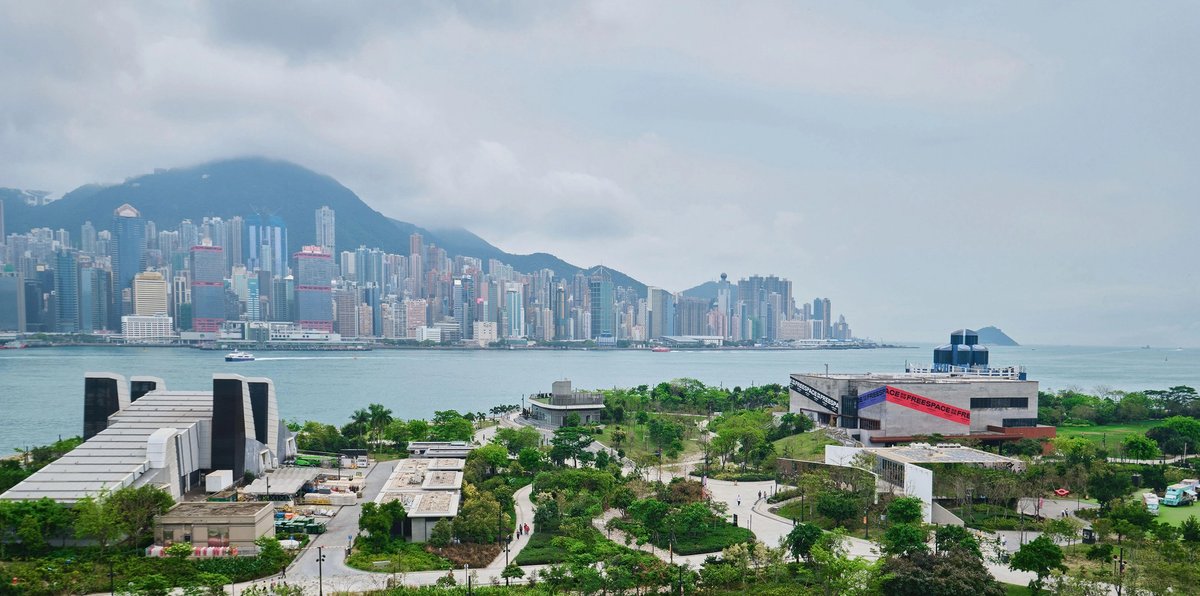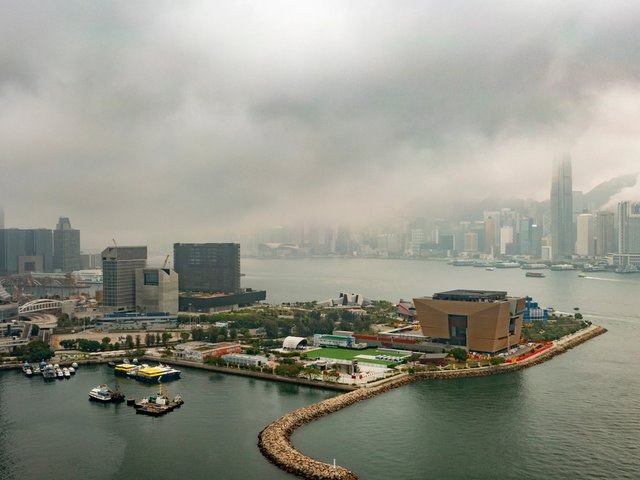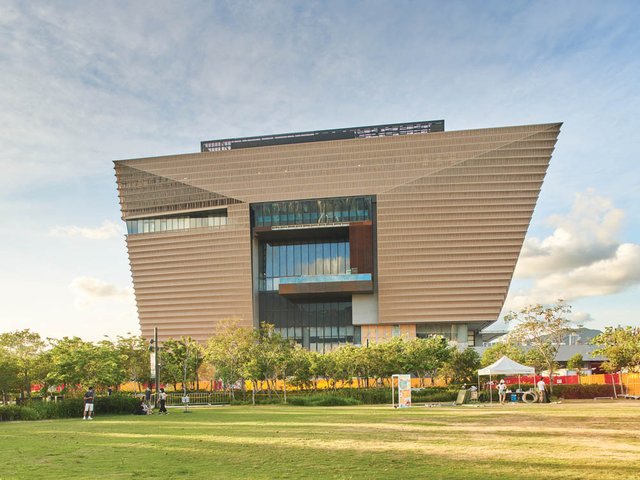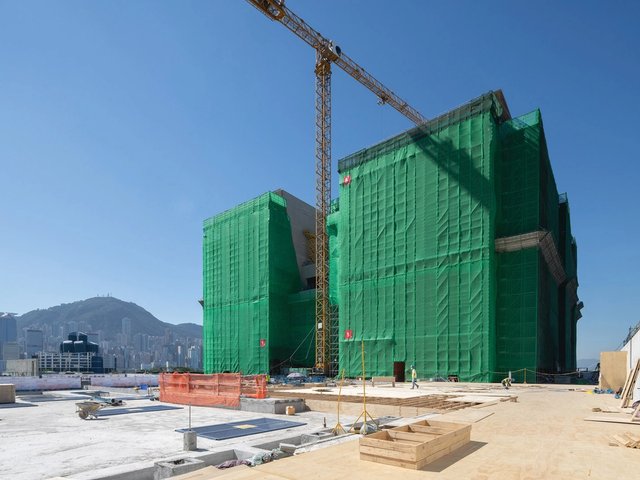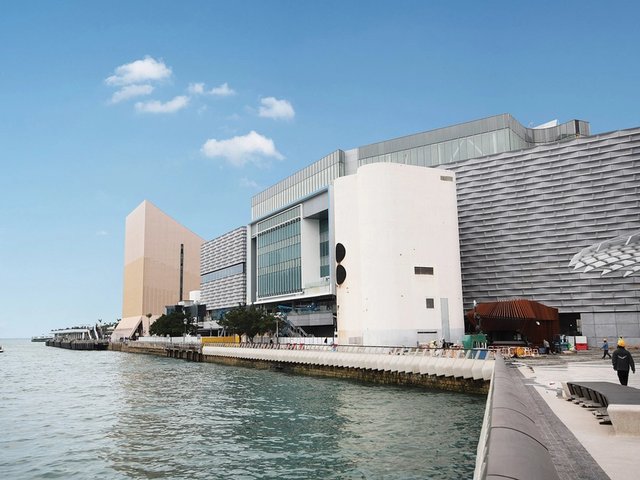Hong Kong politicians first floated the idea to develop a world-class arts hub on a wedge of reclaimed land on Kowloon peninsula in 1998, shortly after the handover of the former British colony to China. Advocates called it a “golden opportunity” that would put Hong Kong on a par with other leading cities, silencing criticism that it was a “cultural desert”. In 2008, the Hong Kong government awarded the West Kowloon Cultural District Authority a one-off upfront endowment of HK$21.6bn (US$2.8bn) to make that arts hub happen.
The mega project is today one of the world’s largest cultural quarters and a magnet for tourists, bolstering Hong Kong’s image as a global city. Spanning 40 hectares alongside Victoria Harbour, the district hosts the M+ museum of contemporary visual culture, the Hong Kong Palace Museum and two performing arts venues—the Xiqu Centre and Freespace. The Lyric Theatre Complex is under construction for a target opening in 2026.
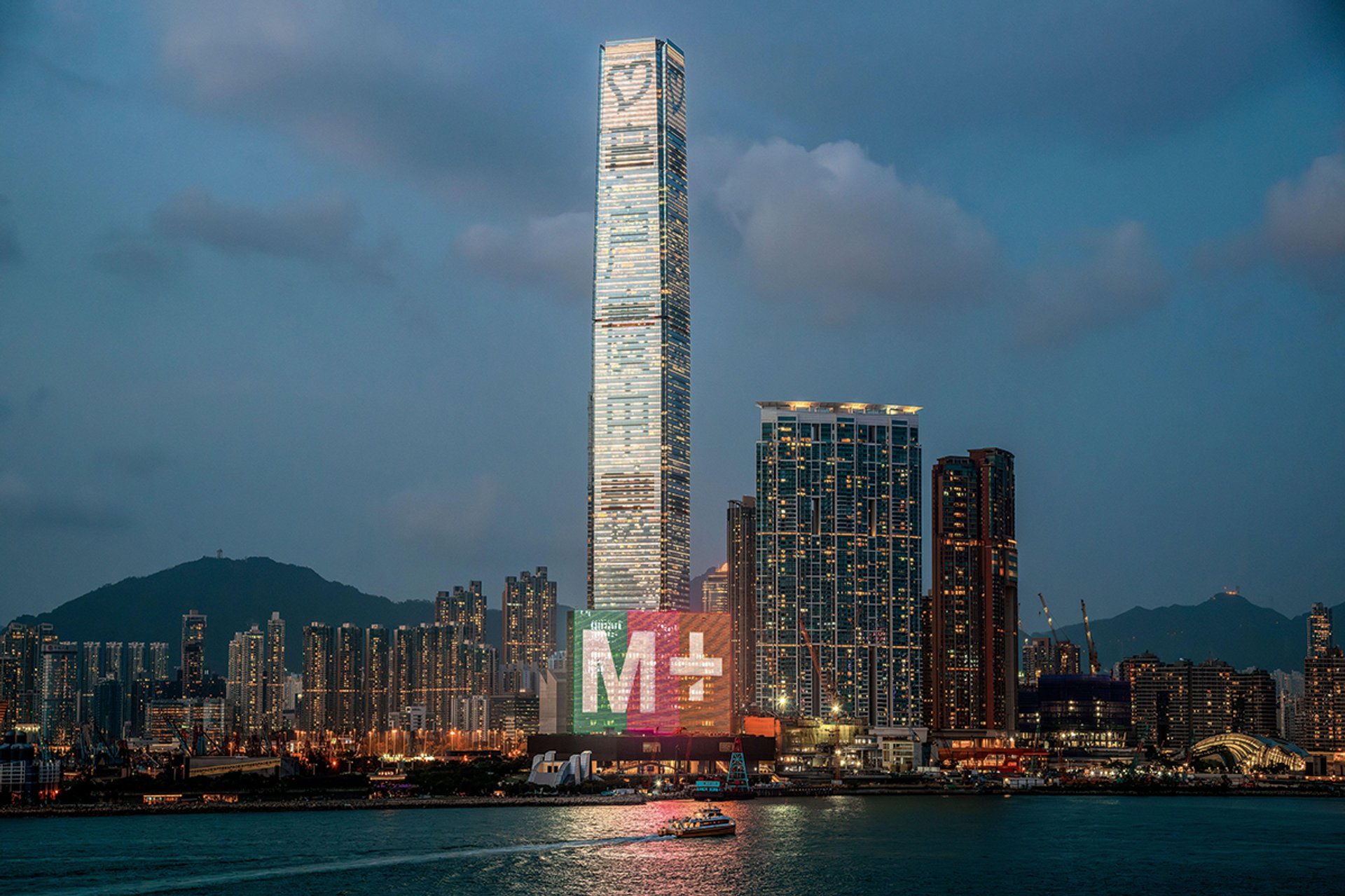
Lighting up the city: the 110m-wide M+ Facade displays artworks programmed by the M+ museum, a building around twice the size of Tate Modern in London Bob Henry/Alamy Stock Photo
After years of delays, the arts hub masterplan reached a milestone in November 2021 with the highly anticipated opening of M+ in a spectacular building around twice the size of London’s Tate Modern. Local Covid-19 restrictions forced the museum to close again for more than two months in 2022, but it still managed to clock up two million visitors in its first year.
Meanwhile, the Hong Kong Palace Museum was first announced in late 2016 as an anniversary gift celebrating Hong Kong’s return to China. Displaying more than 900 Chinese imperial treasures on loan from the Palace Museum in Beijing, it drew 1.3 million visitors in the first year after it opened in July 2022. It has also hosted high-profile exhibitions with international partners, such as the current touring show of masterpieces from the National Gallery in London (Botticelli to Van Gogh, until 11 April).
Cultural exchanges
The West Kowloon Cultural District’s global ambitions are reflected in the international culture conference (with the title “Connecting Cultures, Bridging Times”) that it hosted this week. Speakers included the artist Refik Anadol, the architect Ma Yansong and the heads of museums from Madrid to Doha, San Francisco to Tokyo. The summit marked the signing of collaborative agreements between the district’s flagship venues and more than 20 cultural institutions around the world to “foster international cultural exchange and long-term partnerships”.

Extra yearly operating expense: the Hong Kong Palace Museum was a surprise addition to the West Kowloon Cultural District in 2016 LT/Alamy Stock Photo
But against this optimistic backdrop, senior officials warn that the district is facing major financial challenges that could force it to halt future programming. Betty Fung, the chief executive of the West Kowloon Cultural District Authority (WKCDA), told local media last summer that the Hong Kong government’s 2008 endowment was projected to run out by March 2025.
The authority’s chairman, Henry Tang Ying-yen, recently confirmed to the South China Morning Post that WKCDA is waiting for the government to approve new funding arrangements that were proposed last year. If no decision has been made by June, the district will need to pause contracts for future events. Tang told the newspaper: “If I know I don’t have money and still sign a contract with an arts group or for an exhibition, it is no different than writing a bounced cheque, which is illegal.”
Budget shortfall
A source close to the arts hub project tells The Art Newspaper the hole in the budget “has always been there” since its endowment in 2008. The government’s lump sum was primarily intended to cover the capital costs of building and maintaining the arts venues. Revenue to support their operating costs was expected to come from the commercial rental of retail, dining and entertainment outlets on the site.
Notably, the Hong Kong Palace Museum was not included in the scope of the original funding deal. A late addition to the precinct in 2016, the Palace Museum project was instead funded with a donation of HK$3.5bn from the Hong Kong Jockey Club Charities Trust. Sustaining the Palace Museum costs the district authority around HK$400m (US$52m) a year in operating expenses.
The government threw WKCDA an “enhanced financial arrangement” lifeline in 2016, allowing it to tender out part of the site to private developers of hotels, offices and residential units so it could generate additional rental income. But the timing of the tender during the pandemic and a weakened property market left “developers with a diminished appetite for investment”, according to the South China Morning Post.
Details of WKCDA’s new financial proposal to the government have not been disclosed, but The Art Newspaper understands the plan hinges on the right to sell properties on the site. Under existing government restrictions, WKCDA can only rent out properties.
The authority “always planned to plug the gap [in the budget] with the sale of real estate”, an anonymous source tells The Art Newspaper. “Lack of income throughout the Covid pandemic also proved problematic.”
The district has nevertheless powered ahead with one substantial commercial initiative. In November 2022, it awarded a 47-year tender to a subsidiary of Sun Hung Kai Properties, one of Hong Kong’s largest developers, to build and operate three office towers near M+ and the Lyric Theatre Complex. “This achievement, set against the backdrop of economic uncertainties, marks a critical juncture for WKCDA, paving the way for subsequent phases in the hotel/office/residential development plan,” a WKCDA spokesperson says.
The spokesperson adds that the district is also seeing “positive outcomes” in its efforts to cut costs and boost revenues. In the 2022/23 financial year, for instance, M+ and the Hong Kong Palace Museum recouped almost half of their respective operating costs (46% and 44%) through self-generated income. Overall, the district’s income from commercial leasing nearly quadrupled during the same period, while fundraising income grew “six-fold” to reach HK$197m. “Through diligent efforts, we have successfully delayed potential funding shortages to mid-2025,” the spokesperson says.
As the clock ticks down, the Hong Kong government says it is trying to resolve the cultural district’s financial woes. “The government is actively exploring solutions,” Kevin Yeung Yun-hung, the secretary for culture, sports and tourism, told Hong Kong’s The Standard newspaper. “We are dedicated to working in concert with the Hong Kong special administrative region government to devise a robust and sustainable financial plan for West Kowloon Cultural District,” the WKCDA spokesperson says.
Visitor incentives
Local culture professionals believe new tax relief schemes may encourage private philanthropy where public funding is falling short.
It’s not just about direct income—just consider its value for tourism and hospitality businessesUli Sigg, collector and former ambassador to China
“I would like the district to give us some additional reasons to visit,” says David Ahlstrom, a business professor at Hong Kong Metropolitan University. “I am not criticising the project, but my impression for several years has been, why aren’t there also little things like themed restaurants and shops, not just the big-ticket attractions, to bring people into the district?”
The WKCDA spokesperson says the district’s “long-term financial strategy” is to generate income from “multiple sources, including ticketing, sponsorship, commercial leasing, as well as the hotel, office and residential developments”, adding that “it will take some time for the full potential of revenue from our commercial projects to materialise”.
This week’s global museums summit reflects how far Hong Kong has already come as a burgeoning cultural centre. Uli Sigg, the Swiss collector and former ambassador to China who made a landmark gift of more than 1,400 works of Chinese contemporary art to M+ in 2012, is keeping the faith in the city’s arts district. West Kowloon “will have a sustainable future”, he tells The Art Newspaper. “It is not just about direct income—just consider its value for tourism and hospitality businesses, like MoMA does for New York or the Tate for London. Why would a city sponsor a project like this for billions and then give up halfway before it could harvest its fruits, culturally and financially?”


